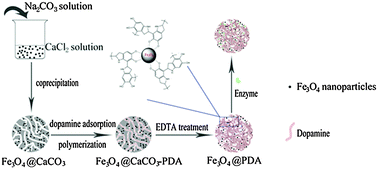Facile preparation of porous magnetic polydopamine microspheres through an inverse replication strategy for efficient enzyme immobilization†
Abstract
An inverse replication method based on porous CaCO3 templates was developed to fabricate porous magnetic polymer microspheres (PMMSs) composed of biocompatible polydopamine and magnetic Fe3O4 nanoparticles. The preparation procedure involved the synthesis of Fe3O4@CaCO3 templates, infiltration and spontaneous polymerization of dopamine in template pores and finally the mild removal of templates. The particle size, the surface morphology and the pore structure (e.g., average pore size, pore volume, surface area, etc.) of porous PMMSs were facilely tailored by altering the templates. The as-prepared polydopamine microspheres PMMSs were applied to covalently immobilize YADH for catalyzing the conversion of formaldehyde to methanol. In comparison to the enzyme-conjugated PDA-coated Fe3O4 nanoparticles (PMNPs), the immobilized enzyme on porous PMMSs exhibited remarkably enhanced activity (specific activity: 162.3 U mg−1 enzyme vs. 97.6 U mg−1 enzyme; methanol yield: 95.5% vs. 57.1%; initial reaction rate: 0.15% s−1vs. 0.08% s−1), and desirable thermal/pH/recycling/storage stabilities, and particularly, easy separation from the bulk solution by an external magnetic field.


 Please wait while we load your content...
Please wait while we load your content...